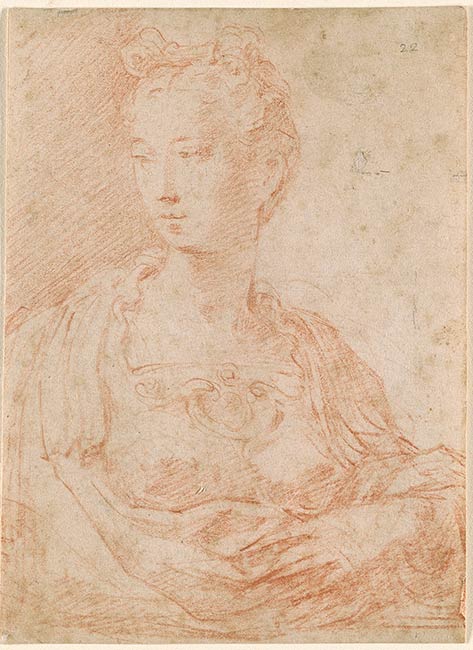
The style of the present drawing dates it to the Parmigianino’s second period in Parma when he was involved with the decoration of the church of Santa Maria della Steccata. It is very likely a study for the painted portrait of Minerva, now unanimously accepted as by Parmigianino, which was formerly at Windsor Castle and is now at Hampton Court Palace, London.1 Sydney Freedberg initially argued that the painting might be a copy derived from a drawing by Parmigianino, perhaps even the Morgan sheet.2 He soon, however, revised his opinion, and indeed, there is no real reason not to consider the Hampton Court picture as an autograph work by the master, as other scholars have consistently noted.3 Paola Rossi dates the painting to around 1530-35, while Cecil Gould dates it to just before Parmigianino’s death.4
Three fragments, two of which are double sided, all on the same Mariette mount (present location unknown), feature pen-and-ink sketches related to the Hampton Court painting. The two double-sided fragments contain Parmigianino’s studies for the pectoral worn by Minerva; the third fragment features a small study of Athena, which, as A. E. Popham noted, may document an alternative idea for the broach.5
The probable early provenance of the Morgan sheet can be inferred from an etching after the drawing by Francesco Rosaspina. As has been noted, Rosaspina probably copied the drawing when it was in the collection of the dealer Giovanni Antonio Armano, who owned almost all the Parmigianino drawings reproduced by Rosaspina. This, in turn, suggests that the drawing was once part of the collection of Thomas Howard, Earl of Arundel, which was purchased in 1720 by Antonio Maria Zanetti.6
Footnotes:
- Hampton Court Palace, London, inv. 405765; Vaccaro 2002, 178-79, no. 33.
- Freedberg 1950, 226.
- Freedberg 1973, 150.
- Rossi 1980, 100-01; Gould 1994, 160.
- Popham 1971, 1: 229, no. 799; Gnann 2007, 486, nos. 838-840.
- Popham 1971, 1: 32-33; Ekserdjian 1999, 8.
Watermark: none.
Inscribed at upper right in graphite, "22"; on verso of lining in graphite, "1674".
Arundel, Thomas Howard, Earl of, 1585-1646, former owner.
Howard, Henry Stafford, Earl of, approximately 1648-approximately 1719, former owner.
Zanetti, Antonio Maria, 1680-1757, former owner.
Armano, Giovanni Antonio, active 18th century, former owner.
Murray, Charles Fairfax, 1849-1919, former owner.
Morgan, J. Pierpont (John Pierpont), 1837-1913, former owner.
Morgan, J. P. (John Pierpont), 1867-1943, former owner.
Selected references: Popham 1949, 176; Freedberg 1950, 226 (as probably Parmigianino); Popham 1971, 1: 123, no. 316; Freedberg 1973, 150; Rossi 1980, 100-01; Di Giampaolo 1991, no. 41; Gould 1994,160, 186, under no. A15; Chiusa 2001, 63 (as possibly not autograph); Vaccaro 2002, 179, under no. 33; Parma and Vienna 2003, 268, no. II.2.27; Di Giampaolo and Fada 2003, 140; Gnann 2007, 485-86, no. 837.
